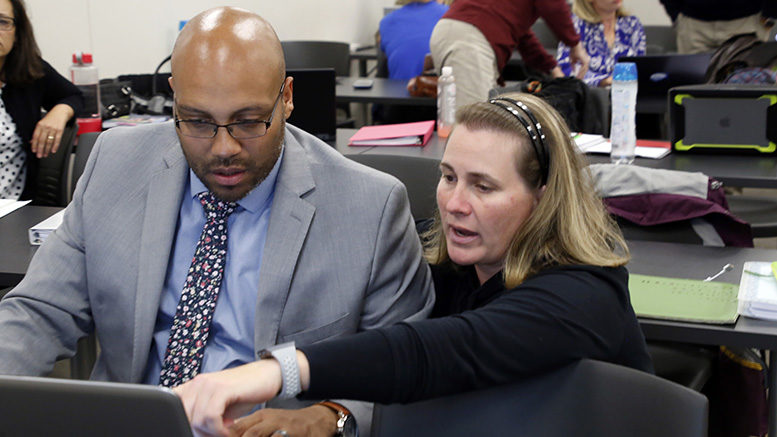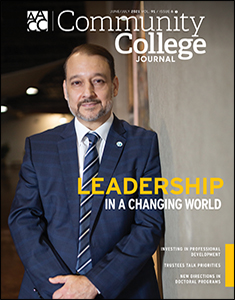How community colleges educate students is an ever-changing proposition, one marked by an increasing number of unfilled leadership positions and an operational landscape even more reliant on labor market outcomes, learning, equity and completion.
A growing number of senior leaders approaching retirement has created a wealth of career opportunities for the next generation of community college executives. In response, state colleges and universities are revamping doctoral degrees in community college education. The goal is to fill vacant management gaps at the highest levels of two-year institutions, and to train future leaders for a brave new world centered on learner access and postgraduate achievement as well.
This is an excerpt from an article in the current issue of Community College Journal, the flagship publication of the American Association of Community Colleges since 1930.
“We’re seeking to develop leaders with our Ed.D. program, not just prepare folks to do research,” says James Bartlett, director of community college leadership programs for North Carolina State University. “We already have a Ph.D. program if you want to do research on two-year institutions.”
A revamped approach
Concerned about the deluge of executives leaving the state’s 58 community colleges, NC State recently redesigned its three-year doctoral degree in adult and community college education. Launched in 2016, the program aligns with curriculum standards set forth by the Aspen Institute and the Carnegie Project on the Education Doctorate (CPED).
The Aspen framework provides evidence-based student success reforms to improve transfer at scale and align programming with job market needs. Principles of CPED include a dissertation in practice and a further shift within the sector to make new presidents more effective.
NC State’s program combines theory, research and practice in striving toward equity, student success, development of internal culture and data-driven decision-making. Modules offer practical leadership guidance taken, in part, from an advisory board populated by experienced two-year administrators.
Via in-person classes and virtual asynchronous and synchronous course meetings, the 110-120 students in NC State’s current doctoral cohort are examining labor market data so the programming they create as administrators reaches learners of all socioeconomic backgrounds.
“We might do a case study about which programs to grow or get rid of. For example, what are some manufacturing jobs we should be talking about?” Bartlett says. “Or when creating an advisory board, let’s use live data regarding the leaders that should be on the board.”
Transitioning with a changing world
Community college leadership efforts are generally designed to build talent pipelines to executive positions at a two-year college or system, even as the type of degree or certificate offered varies by institution. However, the forces driving programmatic change are quite similar, considering the widespread turnover and shifting expectations of today’s leadership, notes Rey Garcia, professor and director of the Community College Policy Administration program at the University of Maryland Global Campus (UMGC).
Garcia arrived at UMGC in September 2019 to evaluate doctoral curriculum, immediately endeavoring to upgrade course work based on obstacles faced by today’s community college leaders.
Ascendium Education awarded the college an $825,000 grant to establish the program, while American Association of Community Colleges (AACC) President and CEO Walter Bumphus served on an advisory committee to guide formation of a new curriculum. The committee includes leaders from community colleges, nonprofit organizations and the workforce sector.
Though UMGC is not accepting students during the redesign process, Garcia expects the program to return this fall. A wholesale update from the old system reflects the comprehensive knowledge base now needed to tackle the vital economic, political and workforce obstacles of the modern higher education landscape, he says.
“The world has changed dramatically since the original program was developed, even as faculty did a good job of keeping curriculum current,” Garcia says. “But you reach a point where you have to look at structural changes, not just making changes around the edges.”
Gauging stakeholders
During the program revamp’s initial phase, officials interviewed community college and workforce leaders, combining feedback with additional data from education policymakers.
Garcia asked his board to think about overarching programming goals, predominately around the concept of two-year colleges as engines of social and economic change. To that end, the first two courses of the new program will encompass an understanding of the community college enterprise and the enrollment it serves.
“The core of what we’re doing feeds off an understanding of the role we play,” Garcia says. “Everyone will have a common base of who we are, who we serve and what we do. It’s all very vision-focused.”
Projected cohorts of 18 to 20 students will likely derive from varied professional backgrounds, including federal agencies and the business world. Though candidates will be given writing prompts on why they want to make a transition into higher ed, attracting business-minded talent is an exciting prospect for administrators keen on workforce development.
As for outreach, UMGC is engaging with organizations at both the state and national level — among them AACC — to draw professionally qualified applicants who appreciate the mission of two-year institutions.
“This will be someone who understands that social and economic mobility are key, and someone who loves the colleges we serve,” Garcia says. “They know we’re not operating in a vacuum and that the environment is rapidly changing. They’re not going to just be engaging with traditional partners in the K-12 and university worlds, but those in the for-profit sector as well.”
Bridging the leadership gulf
“Putting theory into practice” is the watchword for the Ed.D. initiative at Morgan State University. The pathway — open only to individuals with at least one year experience in community college/higher education — follows AACC leadership competencies such as community college advocacy, organizational strategy, resource management and collaboration.
With current presidents grappling with issues like declining federal and state funding, classes concentrate on budgeting and planning or leveraging local companies for investment. Prior to the coronavirus pandemic, Morgan State provided a 15-week internship in the final fall semester of the three-year program. The college delivered last year’s program virtually, with this fall’s effort to return to the face-to-face approach.
Morgan State enrolled 19 new students in the program last fall — a total of 136 would-be admins are currently in the pipeline. Program director Myrtle Dorsey says the glut in community college leadership is not a new phenomenon, as she engaged in these same discussions in the 1990s as a doctorate student at the University of Texas at Austin.
In bridging today’s widening leadership gulf, Morgan State’s curriculum is annually reviewed and updated to anticipate and meet the demands of future community college leaders. Course development follows the Quality Matters standard to ensure institutional and scholar requirements are addressed. Further buoying the program’s curriculum is a presidency course that examines the practical, daily functions of the position, preparing graduates for any number of administrative roles.


